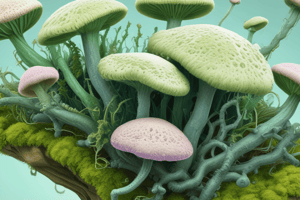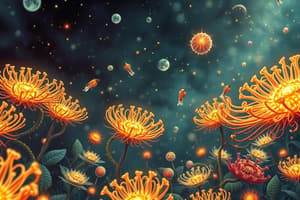Podcast
Questions and Answers
What type of spores are produced during asexual reproduction in fungi?
What type of spores are produced during asexual reproduction in fungi?
- Basidiospores
- Sporangiospores (correct)
- Zygospores
- Meiotic spores
What structural component primarily makes up the cell walls of fungi?
What structural component primarily makes up the cell walls of fungi?
- Cellulose
- Chitin (correct)
- Keratin
- Peptidoglycan
Which structure protects the zygospore during adverse conditions in fungi?
Which structure protects the zygospore during adverse conditions in fungi?
- Hyphae
- Sporangium
- Mycelium
- Zygosporangium (correct)
Where are fungi mostly found in relation to their habitat?
Where are fungi mostly found in relation to their habitat?
What is the primary method of nutrient absorption utilized by fungi?
What is the primary method of nutrient absorption utilized by fungi?
Which of the following accurately describes meiotic spores?
Which of the following accurately describes meiotic spores?
What type of structure is typically formed by fungi for spore dispersal?
What type of structure is typically formed by fungi for spore dispersal?
How do spores benefit from the protection provided by structures like zygosporangia?
How do spores benefit from the protection provided by structures like zygosporangia?
What structure forms in the hymenium of sac fungi to facilitate sexual reproduction?
What structure forms in the hymenium of sac fungi to facilitate sexual reproduction?
How do Rhizopus fungi primarily reproduce?
How do Rhizopus fungi primarily reproduce?
Which of the following diseases is caused by a member of the Ascomycota?
Which of the following diseases is caused by a member of the Ascomycota?
What type of mycelium is characterized by cells that contain a single haploid nucleus?
What type of mycelium is characterized by cells that contain a single haploid nucleus?
What is a major ecological impact of fungal infections in trees, such as those caused by Ophiostoma spp.?
What is a major ecological impact of fungal infections in trees, such as those caused by Ophiostoma spp.?
What is the role of mycelium in fungal survival?
What is the role of mycelium in fungal survival?
What term describes lichens that are embedded in their substrate?
What term describes lichens that are embedded in their substrate?
Which of the following fungi is widely cultivated and consumed for its nutritional value?
Which of the following fungi is widely cultivated and consumed for its nutritional value?
What method of reproduction is most commonly used by fungi?
What method of reproduction is most commonly used by fungi?
Which of the following describes the relationship between arbuscular mycorrhizae and plant roots?
Which of the following describes the relationship between arbuscular mycorrhizae and plant roots?
What unique feature distinguishes plasmodial slime molds from traditional fungi?
What unique feature distinguishes plasmodial slime molds from traditional fungi?
What is a defining characteristic of the Phylum Microsporidia?
What is a defining characteristic of the Phylum Microsporidia?
Which statement is true regarding the storage molecules of fungi?
Which statement is true regarding the storage molecules of fungi?
In what habitat are fungi primarily found?
In what habitat are fungi primarily found?
What is a rare method of asexual reproduction in fungi?
What is a rare method of asexual reproduction in fungi?
Which type of hyphae is characterized by the presence of cross-walls?
Which type of hyphae is characterized by the presence of cross-walls?
Flashcards
Fungal Cell Wall Composition
Fungal Cell Wall Composition
Fungal cell walls are primarily made of chitin, a strong and flexible material.
Fungal Nutrition
Fungal Nutrition
Fungi secrete enzymes to break down food externally, then absorb the digested nutrients.
Zygosporangium
Zygosporangium
A thick-walled structure that protects the zygospore during harsh conditions, formed during sexual reproduction.
Meiotic Spores
Meiotic Spores
Signup and view all the flashcards
Mitotic Spores
Mitotic Spores
Signup and view all the flashcards
Phylum Basidiomycota
Phylum Basidiomycota
Signup and view all the flashcards
Spore Dispersal
Spore Dispersal
Signup and view all the flashcards
Hyphae
Hyphae
Signup and view all the flashcards
Sexual Reproduction (Fungi)
Sexual Reproduction (Fungi)
Signup and view all the flashcards
Zygospore Germination
Zygospore Germination
Signup and view all the flashcards
Monokaryotic Mycelium
Monokaryotic Mycelium
Signup and view all the flashcards
Ascus
Ascus
Signup and view all the flashcards
Dutch Elm Disease
Dutch Elm Disease
Signup and view all the flashcards
Chestnut blight fungus
Chestnut blight fungus
Signup and view all the flashcards
Ascomycota
Ascomycota
Signup and view all the flashcards
Basidiomycota
Basidiomycota
Signup and view all the flashcards
Plasmodium
Plasmodium
Signup and view all the flashcards
Cellular Slime Molds
Cellular Slime Molds
Signup and view all the flashcards
Septate Hyphae
Septate Hyphae
Signup and view all the flashcards
Coenocytic Hyphae
Coenocytic Hyphae
Signup and view all the flashcards
Arbuscules
Arbuscules
Signup and view all the flashcards
Microsporidia
Microsporidia
Signup and view all the flashcards
Study Notes
Kingdom Protista
- Protists are eukaryotic organisms with membrane-bound organelles and a nucleus
- They can be unicellular, colonial, or multicellular
- They exhibit diverse nutritional modes (autotrophic, heterotrophic, or mixotrophic)
- Primarily found in moist or aquatic environments
- Reproduce asexually and sexually
- Exhibit diverse morphologies, ranging from single-celled organisms to large multicellular forms (e.g., seaweeds)
- Play crucial ecological roles (producers, decomposers)
- Have economic importance (food, biofuels, industrial products)
- Some protists cause diseases (e.g., malaria) and serve as research models
Diatoms
- Unicellular algae characterized by silica-based cell walls called frustules
- Major components of phytoplankton, with roles in aquatic food webs and carbon cycling
- Two main types: centric (radial symmetry) and pennate (bilateral symmetry)
- Eukaryotic cells with photosynthetic organelles (chloroplasts) and other typical organelles
- Their distinctive frustules are valuable tools for identification
- Originated through secondary symbiosis, engulfment of a red alga
Brown Algae (Ochrophytes)
- Multicellular algae with cellulose walls
- Primarily found in marine environments, often forming kelp forests
- Asexual and sexual reproduction
- Exhibit a wide range of shapes and structures; varied morphological diversities
Red Algae (Rhodophyta)
- Mostly multicellular, seaweed-like organisms
- Thrive in warmer, deeper marine waters
- Contain pigments called phycobilins, giving them red coloration
- Often form delicate, feathery or branched structures
- Thallus - plant body of the algae
- Three types of thallus: male gametophyte, female gametophyte, tetrasporophyte
- Reproduce with non-moving gametes carried by water currents
Dinoflagellates (Dinophyta)
- Unicellular protists with cellulose plates called theca and two flagella
- Most are photosynthetic, though some are mixotrophic
- Important components of freshwater and marine ecosystems
- Some species produce toxins that can build up in shellfish (red tides)
Euglenoids
- Unicellular algae inhabit freshwater environments and some sewage treatment areas
- Spindle-shaped, without a rigid cell wall. Instead have a pellicle (elastic covering) for shape flexibility
- Two flagella: whip-like structures for movement and to detect light
- Some are photosynthetic, while others are heterotrophic
- Exhibit diverse nutritional modes (autotrophic, heterotrophic, or mixotrophic)
Slime Molds (Myxogastria)
- Heterotrophic
- Feeding via phagocytosis; absorb organic matter
- Some alternate between amoeboid, motile and stationary spore-producing stages
- Cell walls lack chitin
Water Molds (Oomycota)
- Saprotrophic or parasitic fungi-like protists.
- Cell walls primarily composed of cellulose.
- Reproduce using flagellated zoospores
- Often found in aquatic environments, damp soil, and as plant pathogens.
Kingdom Fungi
- Eukaryotic organisms
- Heterotrophic nutrition, absorb rather than ingest nutrients
- Cell walls composed of chitin
- Lack chlorophyll
- Absorptive nutrition
- Composed of network of filaments called hyphae creating mycelium
- Asexual and sexual reproduction using spores
- Store energy as glycogen.
Phylum Chytridiomycota
- Primarily aquatic, with some terrestrial species
- Uni or multicellular
- Produce flagellated zoospores, the only motile fungal spores
- Often considered the most primitive fungi, sharing evolutionary links with protists
- Saprophytic or parasitic, especially on amphibians (causing chytridiomycosis)
Phylum Zygomycota
- Primarily terrestrial, found in soil, decaying matter, or as parasites
- Coenocytic hyphae (multinucleate)
- Form a thick-walled zygosporangium during sexual reproduction to protect the zygospore under adverse conditions
- Asexually reproduce using sporangiospores
- Examples: Rhizopus (black bread mold), Mucor
Phylum Glomeromycota
- Mostly terrestrial, forming symbiotic relationships with plant roots
- Coenocytic hyphae
- Obligate symbionts, forming arbuscular mycorrhizae. These increase surface area and enhance water absorption
- Asexually reproduce through large, multinucleate spores
- No known sexual reproduction
Phylum Ascomycota
- Diverse habitats (soil, decaying matter, plants, and symbionts, including lichens)
- Septate hyphae (divided by cross walls)
- Distinguished by ascus (sac-like structure where sexual ascospores are produced) along with ascocarp (fruiting body surrounding the asci)
- Includes unicellular yeasts, molds, and more complex organisms like morels and truffles
- Reproduct asexually (conidia or budding)
- Reproduce sexually by producing ascospores in asci, often contained in ascocarps,
Phylum Basidiomycota
- Primarily terrestrial (forests, soil, decaying matter)
- Septate hyphae
- Distinguished by basidium (club-shaped structure that produces basidiospores) and often complex fruiting bodies like mushrooms, puffballs
- Asexual reproduction rare (conidia or fragmentation)
- Sexual reproduction involves basidiospores produced on basidia, usually on fruiting bodies
Phylum Microsporidia
- Obligate intracellular parasites, infect animals (especially insects and humans)
- Unicellular, lack typical fungal features like mitochondria
- Reproduce through spore formation using a polar tube to inject their genetic material into host cells
Lichens
- Symbiotic association of fungi and photosynthetic organisms
- Thallus - body of the lichen
- Three main types: crustose (crust-like), foliose (leaf-like), and fruticose (shrub-like)
- The fungal component is more readily identified and used for lichen classification
Bryophytes
- Non-vascular, non-flowering plants
- Thriving in moist, shady environments
- Requires water for fertilization
- Lack of true roots, stem, and leaves, instead have specialized root-like structures (rhizoids)
- Dominant gametophyte generation
- Reproduce via spores
Studying That Suits You
Use AI to generate personalized quizzes and flashcards to suit your learning preferences.




